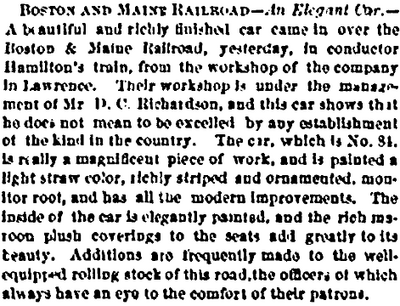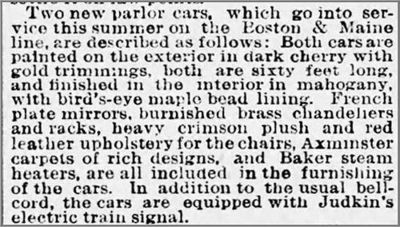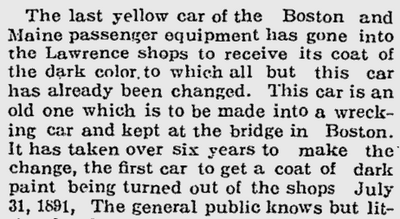Difference between revisions of "Boston & Maine Paint Information"
Josh Bernard (talk | contribs) m (rearranged 1890 phrasing for clarity) |
(Added images, reworded, and fixed links. Paint info will temporarily remain on this page until a dedicated page is created.) |
||
| Line 6: | Line 6: | ||
'''1890''' | '''1890''' | ||
Box cars painted lead color, or slate, with mineral brown roofs, black ironwork, and yellow block letters. Flat cars and coal cars painted mineral brown. | |||
''[https://chroniclingamerica.loc.gov/lccn/sn83016025/1890-07-29/ed-1/seq-4/ | [[File:Portland_Daily_Press_(Portland,_ME),_29_July_1890.jpg|400px]] | ||
''[https://chroniclingamerica.loc.gov/lccn/sn83016025/1890-07-29/ed-1/seq-4/ Portland Daily Press (Portland, ME), 29 July 1890]'' | |||
"Lead Color" was given as being a mix of Keg Lead (white) and lampblack. | "Lead Color" was given as being a mix of Keg Lead (white) and lampblack. | ||
''[https://archive.org/details/carriagepainters00gard/page/28/mode/1up | ''[https://archive.org/details/carriagepainters00gard/page/28/mode/1up The carriage painters' illustrated manual, 1877]'' | ||
'''1897''' | '''1897''' | ||
All freight cars except cabooses, refrigerator and line cars, | All freight cars, except cabooses, refrigerator cars, and line cars, repainted mineral brown (a new shade, slightly darker than the color used previously) with white Roman lettering. Trucks and ironwork also painted mineral brown. Refrigerator cars, cabooses, and line cars continue to have ironwork painted black. | ||
''[https://catalog.lindahall.org/discovery/delivery/01LINDAHALL_INST:LHL/1285783840005961?lang=en | [[File:Railroad_Car_Journal,_December_1897.jpg|400px]] | ||
''[https://catalog.lindahall.org/discovery/delivery/01LINDAHALL_INST:LHL/1285783840005961?lang=en Railroad Car Journal, December 1897]'' | |||
As the result of a boxcar accidentally being lettered "Boston & Mitane," the railroad adopted a new outshopping stencil that identified which paint shop was last to paint each car, using the first three letters of the shop's name (Lawrence, Salem, or Somerville). Stencil was six inches across. | As the result of a boxcar accidentally being lettered "Boston & Mitane," the railroad adopted a new outshopping stencil that identified which paint shop was last to paint each car, using the first three letters of the shop's name (Lawrence, Salem, or Somerville). Stencil was six inches across. | ||
| Line 28: | Line 32: | ||
'''1871''' | '''1871''' | ||
Passenger cars painted light straw and "richly striped and ornamented" | Passenger cars painted light straw yellow and "richly striped and ornamented" | ||
[[File:The_Boston_Traveler_(Boston,_MA),_16_May_1871.png|400px]] | |||
''The Boston Traveler (Boston, MA), 16 May 1871'' | ''The Boston Traveler (Boston, MA), 16 May 1871'' | ||
| Line 34: | Line 40: | ||
'''1873''' | '''1873''' | ||
B&M Wagner parlor car painted wine and striped in gold leaf. | |||
[[File:The_Boston_Globe_(Boston,_MA),_9_July_1873.jpg|400px]] | |||
''The Boston Globe (Boston, MA), 9 July 1873'' | ''The Boston Globe (Boston, MA), 9 July 1873'' | ||
| Line 42: | Line 50: | ||
Parlor cars painted dark maroon. | Parlor cars painted dark maroon. | ||
''[https://catalog.lindahall.org/discovery/delivery/01LINDAHALL_INST:LHL/1286056230005961?lang=en | [[File:The_National_Car_Builder,_August_1882,_pg._89_B&M.png|400px]] | ||
''[https://catalog.lindahall.org/discovery/delivery/01LINDAHALL_INST:LHL/1286056230005961?lang=en The National Car Builder, August 1882, pg. 89]'' | |||
'''1884''' | '''1884''' | ||
| Line 48: | Line 58: | ||
Parlor cars painted lake with gold ornamentation. | Parlor cars painted lake with gold ornamentation. | ||
''[https://catalog.lindahall.org/discovery/delivery/01LINDAHALL_INST:LHL/1286056230005961?lang=en | [[File:The_National_Car_Builder,_July_1884,_pg._81.png|400px]] | ||
''[https://catalog.lindahall.org/discovery/delivery/01LINDAHALL_INST:LHL/1286056230005961?lang=en The National Car Builder, July 1884, pg. 81]'' | |||
'''1885''' | '''1885''' | ||
Passenger car "Magnolia" painted deep crimson | Passenger car, "Magnolia," assigned to the Eastern Division, painted deep crimson. | ||
[[File:The_Boston_Evening_Transcript_(Boston,_MA),_22_May_1885.png|400px]] | |||
''[https://books.google.ca/books?id=3UMzAAAAIBAJ&pg=PA2#v=onepage&q&f=false The Boston Evening Transcript (Boston, MA), 22 May 1885]'' | |||
Baggage cars of the Eastern Division repainted from a yellow-brown to Tuscan red. | |||
[[File:The_Portland_Daily_Press_(Portland,_ME),_14_February_1885.jpg|400px]] | |||
''[https://chroniclingamerica.loc.gov/lccn/sn83016025/1885-02-14/ed-1/seq-4/ | ''[https://chroniclingamerica.loc.gov/lccn/sn83016025/1885-02-14/ed-1/seq-4/ The Portland Daily Press (Portland, ME), 14 February 1885]'' | ||
'''1886''' | '''1886''' | ||
Two new parlor cars painted dark cherry with gold ornamentation. | Two new parlor cars painted dark cherry with gold ornamentation. | ||
[[File:The_Boston_Globe_(Boston,_MA),_3_June_1886.jpg|400px]] | |||
''The Boston Globe (Boston, MA), 3 June 1886'' | ''The Boston Globe (Boston, MA), 3 June 1886'' | ||
Passenger and baggage cars painted light straw. Interiors finished in mahogany with black walnut trim. | Passenger cars and baggage cars painted light straw yellow. Interiors finished in mahogany with black walnut trim. | ||
''[https://chroniclingamerica.loc.gov/lccn/sn83016025/1886-09-07/ed-1/seq-1/ | [[File:The_Portland_Daily_Press_(Portland,_ME),_7_September_1886.png|400px]] | ||
''[https://chroniclingamerica.loc.gov/lccn/sn83016025/1886-09-07/ed-1/seq-1/ The Portland Daily Press (Portland, ME), 7 September 1886]'' | |||
'''1890''' | '''1890''' | ||
Baggage cars repainted from Tuscan | Baggage cars repainted from Tuscan red to yellow. | ||
[[File:The_Beverly_Citizen_(Beverly,_MA),_22_November_1890.png|400px]] | |||
''The Beverly Citizen (Beverly, MA), 22 November 1890'' | ''The Beverly Citizen (Beverly, MA), 22 November 1890'' | ||
''[https://chroniclingamerica.loc.gov/lccn/sn83016025/1890-11-29/ed-1/seq-4/ | [[File:The_Portland_Daily_Press_(Portland,_ME),_29_November_1890.jpg|400px]] | ||
''[https://chroniclingamerica.loc.gov/lccn/sn83016025/1890-11-29/ed-1/seq-4/ The Portland Daily Press (Portland, ME), 29 November 1890]'' | |||
'''1891''' | '''1891''' | ||
Passenger cars assigned to the | Passenger cars assigned to the Eastern and Western divisions begin to be painted dark olive green with gold lettering. Passenger cars assigned to the Lowell division already dark olive green with gold lettering. | ||
[[File:The_Portland_Daily_Press_(Portland,_ME),_26_November_1891.png|400px]] | |||
''[https://chroniclingamerica.loc.gov/lccn/sn83016025/1891-11-26/ed-1/seq-1/ | ''[https://chroniclingamerica.loc.gov/lccn/sn83016025/1891-11-26/ed-1/seq-1/ The Portland Daily Press (Portland, ME), 26 November 1891]'' | ||
'''1892''' | '''1892''' | ||
New passenger cars built this year | New passenger cars built this year all painted olive green with gold striping. | ||
[[File:The_Daily_Kennebec_Journal_(Augusta,_ME),_10_March_1892.png|400px]] | |||
''[https://chroniclingamerica.loc.gov/lccn/sn82014248/1892-03-10/ed-1/seq-2/ | ''[https://chroniclingamerica.loc.gov/lccn/sn82014248/1892-03-10/ed-1/seq-2/ The Daily Kennebec Journal (Augusta, ME), 10 March 1892]'' | ||
'''1893''' | '''1893''' | ||
| Line 94: | Line 122: | ||
One source claims that B&M passenger cars are painted white giving the railroad the nickname "Ghost Line." This is dubious. | One source claims that B&M passenger cars are painted white giving the railroad the nickname "Ghost Line." This is dubious. | ||
''[https://drive.google.com/file/d/1Lig1Cop92f8xWXbUY0oCPLeCUx_ap5tf/view?usp=sharing | [[File:The_Pittsburgh_Daily_Post_(Pittsburgh,_PA),_24_February_1893_B&A.jpg |400px]] | ||
''[https://drive.google.com/file/d/1Lig1Cop92f8xWXbUY0oCPLeCUx_ap5tf/view?usp=sharing The Pittsburgh Daily Post (Pittsburgh, PA), 24 February 1893]'' | |||
Pullman coaches used on the B&M painted "regulation Pullman Color" | Pullman coaches used on the B&M painted "regulation Pullman Color" | ||
''[https://chroniclingamerica.loc.gov/lccn/sn83016025/1893-09-14/ed-1/seq-8/ | [[File:The_Portland_Daily_Press_(Portland,_ME),_14_September_1893.png|400px]] | ||
''[https://chroniclingamerica.loc.gov/lccn/sn83016025/1893-09-14/ed-1/seq-8/ The Portland Daily Press (Portland, ME), 14 September 1893]'' | |||
'''1897''' | '''1897''' | ||
The last yellow car is repainted "dark," completing a six-year repainting process. | The last yellow passenger car is repainted "dark," completing a six-year repainting process. | ||
[[File:The_Lewiston_Evening_Journal_(Lewiston,_ME),_2_October_1897.png|400px]] | |||
''[https://books.google.ca/books?id=wtAgAAAAIBAJ&pg=PA4#v=onepage&q&f=false | ''[https://books.google.ca/books?id=wtAgAAAAIBAJ&pg=PA4#v=onepage&q&f=false The Lewiston Evening Journal (Lewiston, ME), 2 October 1897]'' | ||
[[Reference]] / [[Historic Railroad Paint Color Index]] | [[Reference]] / [[Historic Railroad Paint Color Index]] | ||
Revision as of 17:14, 2 February 2022
Reference / Historic Railroad Paint Color Index
Freight Cars
1890
Box cars painted lead color, or slate, with mineral brown roofs, black ironwork, and yellow block letters. Flat cars and coal cars painted mineral brown.
Portland Daily Press (Portland, ME), 29 July 1890
"Lead Color" was given as being a mix of Keg Lead (white) and lampblack.
The carriage painters' illustrated manual, 1877
1897
All freight cars, except cabooses, refrigerator cars, and line cars, repainted mineral brown (a new shade, slightly darker than the color used previously) with white Roman lettering. Trucks and ironwork also painted mineral brown. Refrigerator cars, cabooses, and line cars continue to have ironwork painted black.
Railroad Car Journal, December 1897
As the result of a boxcar accidentally being lettered "Boston & Mitane," the railroad adopted a new outshopping stencil that identified which paint shop was last to paint each car, using the first three letters of the shop's name (Lawrence, Salem, or Somerville). Stencil was six inches across.
Railroad Car Journal June 1897
Passenger Equipment
1871
Passenger cars painted light straw yellow and "richly striped and ornamented"
The Boston Traveler (Boston, MA), 16 May 1871
1873
B&M Wagner parlor car painted wine and striped in gold leaf.
The Boston Globe (Boston, MA), 9 July 1873
1882
Parlor cars painted dark maroon.
The National Car Builder, August 1882, pg. 89
1884
Parlor cars painted lake with gold ornamentation.
The National Car Builder, July 1884, pg. 81
1885
Passenger car, "Magnolia," assigned to the Eastern Division, painted deep crimson.
The Boston Evening Transcript (Boston, MA), 22 May 1885
Baggage cars of the Eastern Division repainted from a yellow-brown to Tuscan red.
The Portland Daily Press (Portland, ME), 14 February 1885
1886
Two new parlor cars painted dark cherry with gold ornamentation.
The Boston Globe (Boston, MA), 3 June 1886
Passenger cars and baggage cars painted light straw yellow. Interiors finished in mahogany with black walnut trim.
The Portland Daily Press (Portland, ME), 7 September 1886
1890
Baggage cars repainted from Tuscan red to yellow.
The Beverly Citizen (Beverly, MA), 22 November 1890
The Portland Daily Press (Portland, ME), 29 November 1890
1891
Passenger cars assigned to the Eastern and Western divisions begin to be painted dark olive green with gold lettering. Passenger cars assigned to the Lowell division already dark olive green with gold lettering.
The Portland Daily Press (Portland, ME), 26 November 1891
1892
New passenger cars built this year all painted olive green with gold striping.
The Daily Kennebec Journal (Augusta, ME), 10 March 1892
1893
One source claims that B&M passenger cars are painted white giving the railroad the nickname "Ghost Line." This is dubious.
The Pittsburgh Daily Post (Pittsburgh, PA), 24 February 1893
Pullman coaches used on the B&M painted "regulation Pullman Color"
The Portland Daily Press (Portland, ME), 14 September 1893
1897
The last yellow passenger car is repainted "dark," completing a six-year repainting process.
The Lewiston Evening Journal (Lewiston, ME), 2 October 1897

















